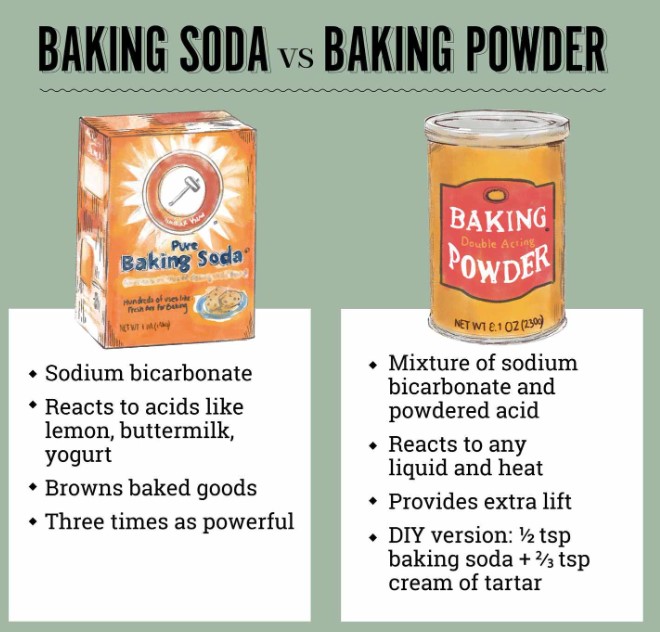BOURSESSENEGAL – Baking soda vs baking powder can be a confusing topic for many home bakers. Both ingredients play a crucial role in leavening baked goods, but they are not interchangeable. Knowing how they work and when to use each can significantly affect your baking results. In this article, we’ll dive into the characteristics, uses, and differences between baking soda vs baking powder, ensuring that you have a clear understanding for your next culinary adventure.
What is Baking Soda?
Baking soda, also known as sodium bicarbonate, is a chemical leavening agent that requires an acid to activate. When baking soda combines with an acid and moisture, it produces carbon dioxide gas, which helps baked goods rise. This reaction occurs quickly, which is why recipes often call for baking soda to be baked immediately after mixing.
How Baking Soda Works in Baking
To illustrate how baking soda works, think of a recipe that includes acidic ingredients like vinegar, yogurt, or buttermilk. When you add baking soda to the mixture, the acid activates the baking soda. This reaction creates bubbles of carbon dioxide gas, causing the batter to rise and creating a light, airy texture in the final product.
Common Uses for Baking Soda
Baking soda isn’t just for baking; it has several uses in the kitchen and beyond. Here are some common applications:
- Baking: Ideal for recipes that include acidic ingredients.
- Cleaning: A natural abrasive cleaner that deodorizes surfaces.
- Deodorizing: Effective for eliminating odors in refrigerators or carpets.
- Laundry: Can enhance detergent performance and remove stains.
What is Baking Powder?
Baking powder is another leavening agent, but it contains baking soda along with an acid, usually cream of tartar, and a moisture-absorbing agent like starch. Unlike baking soda, baking powder can leaven baked goods without any additional acidic ingredients.
How Baking Powder Works in Baking
Baking powder comes in two types: single-acting and double-acting.
- Single-Acting Baking Powder: Reacts and releases carbon dioxide as soon as it gets wet. This means you need to bake the mixture immediately.
- Double-Acting Baking Powder: Produces gas in two phases: once when mixed with wet ingredients and again when exposed to heat. This gives you more flexibility with baking times.
Common Uses for Baking Powder
Baking powder is used in recipes that do not contain acidic ingredients. Here are its common applications:
- Baking: Perfect for cakes, muffins, and cookies without acidic components.
- Thickening Agent: Used in gravies and sauces.
- Quick Breads: Ideal for recipes like pancakes and waffles.
Key Differences Between Baking Soda vs Baking Powder
Understanding the differences between baking soda and baking powder will help you choose the right ingredient for your recipe. Let’s break down the main distinctions:
1. Composition
- Baking Soda: Pure sodium bicarbonate.
- Baking Powder: Contains baking soda, an acid, and a moisture-absorbing agent.
2. Activation
- Baking Soda: Requires an acid to activate.
- Baking Powder: Can work alone because it contains its own acid.
3. Usage in Recipes
- Baking Soda: Best for recipes with acidic ingredients (e.g., buttermilk, vinegar).
- Baking Powder: Ideal for recipes without additional acids.
4. Flavor
Baking soda can impart a slight metallic taste if used in excess, while baking powder typically has a neutral flavor, making it preferable for sweeter baked goods.
Substituting Baking Soda and Baking Powder
When a recipe calls for one ingredient and you only have the other, you may be tempted to substitute. However, keep in mind that these ingredients aren’t interchangeable on a one-to-one basis.
Substituting Baking Powder for Baking Soda
If you’re out of baking soda but have baking powder, you can use it as a substitute. However, since baking powder is less potent, you’ll need to use about three times as much baking powder. For example, if a recipe calls for 1 teaspoon of baking soda, use 3 teaspoons of baking powder. Keep in mind that this could alter the flavor and texture.
Substituting Baking Soda for Baking Powder
Conversely, if you need to substitute baking powder for baking soda, you can do this by adding an acid to the recipe. For every teaspoon of baking powder, use 1/4 teaspoon of baking soda and add 1/2 teaspoon of vinegar or lemon juice to activate it.
Baking Tips for Best Results
1. Measure Accurately
Use the correct measuring tools to ensure you add the right amount. Too much or too little can impact your baked goods’ texture and taste.
2. Check Expiration Dates
Baking soda and baking powder lose potency over time. Test them before using: add a little vinegar to baking soda; if it bubbles vigorously, it’s still good. For baking powder, add hot water; if it bubbles, it’s active.
3. Follow Recipes Closely
When baking, precision is crucial. If a recipe specifies baking soda or baking powder, don’t switch unless you fully understand how the substitution will affect the final product.
4. Store Properly
Keep baking soda and baking powder in a cool, dry place. Store them in airtight containers to prevent moisture absorption.
Conclusion
In the battle of baking soda vs baking powder, each ingredient has its unique role in the kitchen. Understanding their differences helps you make informed decisions when baking. Always remember that baking soda requires an acid to work, while baking powder contains everything it needs to leaven your baked goods. By mastering these leavening agents, you can elevate your baking skills and enjoy delicious results every time. So the next time you step into the kitchen, you’ll know exactly how to choose between baking soda and baking powder for the best outcomes. Happy baking!
REFERENCE : pepesislot



